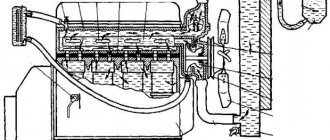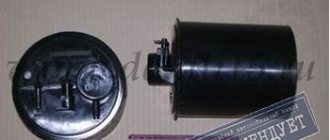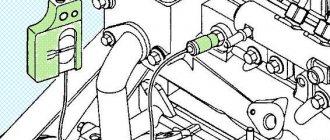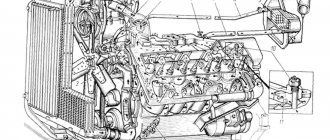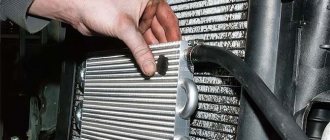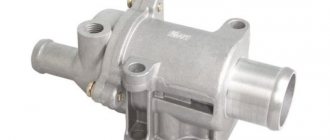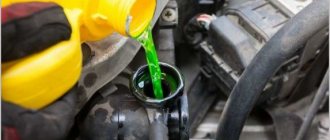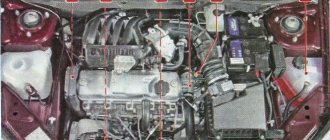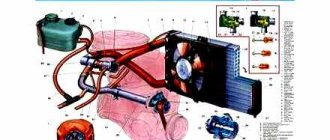UAZ Bukhanka engine oil
Today you can hear many different names for one of the oldest creations of Ulyanovsk auto, “Tabletka”, “Baton”.
Their story began in 1965, when the first UAZ series rolled off the assembly line, and continues to this day. During this time, the model received updates several times, but even after decades of mass production, design changes never appeared in it. Utility Loaves were presented only with front-wheel drive and included a range of vehicles: carriage models, vans, trucks, minibuses and medical vehicles. Over more than 50 years of production history, the model was equipped with different engines - UMZ and ZMZ with working volumes of 2.45, 2.7 and 2.9 liters. Since the 60s, 4-cylinder 2.45 liter units producing 74-76 hp have been operating under the hood. with a 4-speed manual transmission. A little later, the engine was replaced with a 2.9-liter engine with 84 and 86 hp. And the injection version with 99 hp is responsible for the operation of the car 22069. With each new engine, the Bukhanka became more economical and dynamic, which only fueled the interest of fans of the domestic automobile industry in it. You can find out what kind of oil and how much to pour into the listed engines further in the article.
Of course, when compared with modern imported cars of the same class, the Russian Bukhanka looks very modest and unusual. However, we should not forget that the initial purpose of the vehicle’s production was to conquer off-road conditions and satisfy the transport needs of the army. Accordingly, in the struggle between endurance, overload and external beauty, the winner was obvious. But the Bukhanka is well adapted to tuning and does not consume so much fuel: 8.4-11.5 liters per 100 km on the highway, depending on the load, and up to 14.5 liters in the urban cycle.
What are the components?
Refill tanks are units that contain working fluids. They periodically require replacement or refueling, just like with a gas tank. By the way, the UAZ Patriot SUV is equipped with two refueling tanks, which allows you to increase the amount of fuel to be filled to almost 80 liters. Few cars of this class can afford such a gas tank design.
Refill volumes include the following devices, mechanisms and parts:
- gas tanks;
- Patriot engine cooling system;
- Transmission;
- the engine, or rather its lubrication system;
- housings of both axles;
- hydraulic power steering system;
- brake system;
- clutch system;
- glass washer pump reservoir;
- transfer case.
UAZ Patriot, as well as other vehicles similar in design and having similar mechanisms, necessarily has the refueling volumes listed above, presented in the form of plastic tanks or located directly in the units themselves. It is in these devices that the filling fluid for a particular mechanism is located. These liquids include the following:
- gasoline or diesel fuel, depending on the design of the engine itself;
- motor and transmission oils, which are filled not only into the engine, but also into the gearbox, transfer case and axles;
- brake fluid poured into the brake mechanism and clutch system of an SUV;
- antifreeze or antifreeze, used for engine cooling and interior heating;
- windshield washer fluid, which is filled into the windshield and rear window washer reservoir.
So, now let's look at the digital values of all the above-mentioned devices, what volumes of working fluid they have and what they represent.
Refueling volumes
For Patriot, refueling volumes correspond to the following data:
- gas tanks: the left tank is designed for 36 liters, as stated by the manufacturer, the right one has the same volume and is 36 liters, although in fact it is known that you can add a little more fuel to the gas tanks;
- the volume of the engine lubrication system is 7 liters, and for UAZ Patriot 31631 models the amount of lubricant is 4.2 liters;
- engine cooling and interior heating system - 12 l, and for a radiator with horizontal tubes the capacity is 14 l;
- The manual gearbox has a volume of 2.5 liters;
- the transfer case is about 0.8 liters;
- The front and rear axles of the rogue have filling volumes that differ in value from each other. So, for the front axle the typical oil filling is 1.5 liters, and for the rear axle - 1.4 liters. But in fact, it is recommended to pour more than 1.4 liters of oil into the rear axle housing so that the working elements inside are completely absorbed by the lubricant;
- power steering - 1.1, and for the UAZ-31631 model - 1.3l;
- steering gear - 0.25;
- clutch drive is 0.18l;
- brake mechanism - 0.6l;
- shock absorbers - 0.32, but it all depends on the devices used in the suspension design;
- The windshield washer reservoir is 5 liters.
All these parameters are important and every owner of his car should have all the numbers. Otherwise, you can always refer to the car’s operating instructions and find out even the smallest details. If you have questions or feedback, you can always leave it at the end of each material.
UAZ-39094 is a commercial vehicle designed for transporting goods.
It has outstanding performance parameters as well as good driving characteristics. Perfect for those involved in agriculture: farmers and other similar persons.
Lubricants and working fluids for UAZ vehicles
List of recommended lubricants, working fluids and substitutes for UAZ
Lubricants
- motor oil
M-8-V, GOST 10541-78 or M-6z/10-V (DV-ASZp-10V) OST 38.01370-84. Northern automobile oil M4z/6V1 OST 38.01370-84. - transmission oil
TSp-15K GOST 23652-79. Substitute: automotive transmission oil TAP-15V or TAD-17I OST 23652-79. At temperatures below minus 20 °C, automotive transmission oil TSp-10 GOST 23652-79. - Lubricant
"Litol-24" GOST 21150-87, "Lita" TU 38.1011308-90 or "Litol-24RK" (grease SHRUS-4 - an analogue of "Litol" with the addition of molybdenum disulfide and other additives that reduce wear) - Graphite lubricant
USSA GOST 3333-80. - Grease
CIATIM 201 GOST 6267-74, CIATIM-221 GOST 9433-80.
Working fluids
- Coolant
TOSOL-A40M, TOSOL-A65M TU 6-02-751-86 (use in winter OZH-40, OZH-65 GOST 28084-89 is allowed) or “Lena-40”, “Lena-65” TU 113- 12-11.104-88. The water is clean and “soft” (rain, snow, boiled). - Shock absorption fluid
AZh-12T GOST 23008-78. Substitute: spindle oil AU OST 38.01.412-86. - Brake fluid
“Tom” TU 6-01-1276-82, “Rosa” TU 6-55-37-90, “Neva” TU 6-01-1163-78, GTZh-22 TU 6-01787-75 (see . also opinions about different brake fluids) - Electrolyte
with density, g/cm3: 1.25 - for areas with temperatures up to -10 ° C; 1.27 - for areas with temperatures up to -30 ° C; 1.29 - for areas with temperatures up to -40 ° C (see also the article “Battery”) - Gasoline
A-76 GOST 2084-77, summer or winter grades.
up
Refueling data for wagon-type vehicles
Standards for consumption of fuels and lubricants in road transport Р3112194-0366-97
approved by the Ministry of Transport of the Russian Federation on February 18, 1997. Valid until 01/01/2002) (Only basic figures, only in relation to UAZ vehicles. Full document: local copy from the Avto-Garant website)
Fuel consumption rates
The standards include the fuel consumption required to carry out the transport process. Installed for general purpose vehicles. basic rate in liters per 100 km of vehicle mileage.
Fuel consumption rates increase (including) under the following conditions:
- work in winter: in the southern regions of the country - up to 5%, in the northern regions of the country - up to 15%, in the Far North and areas equivalent to the Far North - up to 20%, in other regions of the country - up to 10% ( the maximum values of winter allowances for almost all regions of central Russia are 10%, valid for 5 months a year);
- work in cities with a population of over 2.5 million people - up to 20%; with a population of 0.5 to 2.5 million people - up to 15%; with a population of up to 0.5 million people - up to 10%;
- when driving the first thousand kilometers with cars that have undergone major repairs and new ones, as well as. when driving such vehicles under their own power - up to 10%;
- for cars that have been in operation for more than 8 years - up to 5%;
- work in difficult road conditions during seasonal thaw, snow or sand drifts, floods and other natural disasters - up to 35%;
How to change the oil in a UAZ Bukhanka engine with your own hands?
In order for the UAZ Bukhanka car to serve properly for many years, drivers need to regularly undergo technical inspections and also replace consumable parts. Mandatory procedures include changing the engine oil.
The process fluid performs the following functions:
- provides the necessary pressure force;
- effectively lubricates the surfaces of spare parts and prevents their wear;
- removes dirt and prevents blockages in the mechanism;
- regulates normal temperature.
After 70 thousand kilometers, the fluid must be replaced.
It is also recommended to replace the oil filter together with the engine oil. The driver can do this work independently. The following tools will be required:
- Motor fluid of the required viscosity and in sufficient volume. In order to determine what product needs to be poured into the UAZ Bukhanka, you should look at the technical documentation of the vehicle;
- New oil filter;
- A set of standard socket and chisel keys;
- Funnel;
- Empty container for draining waste;
- Clean rags.
Bukhanka engine capacity
The size of the filling volume has also changed in relation to the “Loaf”:
- Both fuel tanks hold 36 liters of gasoline;
- The UAZ Patriot engine needs to be filled with up to 7 liters of oil;
- The gearbox requires 2.5 liters of gear oil;
- The oil capacity in the UAZ Patriot axles is different - 1.5 liters for the front and 1.4 for the rear;
- The transfer case holds only 0.8 liters.
The remaining capacities of these two machine models are equivalent, however, the brands of lubricants and liquids for the Patriot differ from those for the Bukhanka. The new generation of vehicles requires more expensive maintenance. The cost of servicing such a machine does not fit into the economy mode.
As for the third generation of internal combustion engines of the Ulyanovsk Automobile Plant - UMZ 421, it is a minimally modernized version of UMZ 417.
When does the oil change?
The engine oil is most often changed at each scheduled maintenance. However, there are also factors that influence premature oil wear:
- intensive use of the vehicle;
- malfunction of the internal combustion engine mechanism;
- low class liquid (poor quality solution);
- unfavorable weather conditions (sharp drop in temperature).
In new cars (up to 3 years old), it is recommended to replace the fluid every 10 - 13 thousand km. For older cars, this period is reduced to 5 thousand km.
When to change the oil in the transfer case and axles of Bukhanka
It is recommended to change the oil in the transfer case and rear axle gearbox in the UAZ Bukhanka every 30-40 thousand km, depending on operating conditions and the condition of the lubricant. Frequent off-road driving or in city “traffic light” traffic jams, the use of poor quality oil, sudden starts and braking - all this leads to premature wear of internal parts and deterioration in the quality of the lubricant, which are recommended to be replaced as soon as possible. This may also be indicated by characteristic signs: insufficient oil level, extraneous sounds, as well as changes in color and consistency.
The process of changing the oil in the UAZ Bukhanka engine with your own hands
Before draining old fluid from a UAZ Bukhanka car, you need to start the car and leave the engine running for 10 minutes. This way the oil heats up and becomes less viscous, causing it to flow out faster. Repair work should be carried out in a suitable place - a garage or driveway is suitable. It is important to remember that the car must be on a level surface.
The procedure for replacing the internal combustion engine fluid in a UAZ Bukhanka car:
- Initially, you need to turn off the engine;
- Next you need to get under the hood and disconnect the crankcase protection. If there is too little space under the car, you will need a jack;
- Place the container and carefully open the drain hole. The oil may be hot, so wearing gloves is recommended;
- Fluid will drain from the system within 15 minutes. During this time, you can change the oil filter or clean the old one, if possible;
- Before installing a new oil filter, it is necessary to saturate its surface with a small amount of liquid;
- Afterwards the mechanism is installed in its original place;
- New internal combustion engine fluid is poured through a special hole. You can check the level using a metal dipstick.
After this, you need to start the engine and leave it running for 5 minutes. This way the liquid is evenly distributed throughout the system.
Refueling volumes
| Parameter | Automobile model | |||||||||
| 31512 | 3741 | 3962 | 2206 | 3303 | 3909 | 3153 | 33036 | 39094 | 39095 | |
| Fuel tanks | ||||||||||
| left (main) | 39 | 56 | 56 | 56 | 56 | 56 | 39 | 56 | 56 | 56 |
| right (additional) | 39 | 30 | 30 | 30 | 56 | 30 | 39 | 56 | 30 | 56 |
| Engine cooling system (including heater) | 12,5- 12,7 | 13,2- 13,4 | 14,4- 14,6 | 14,4- 14,6 | 13,2- 13,4 | 14,4- 14,6 | 12,5- 12,7 | 13,2- 13,4 | 13,3- 13,4 | 13,2- 13,4 |
| Engine lubrication system (including oil filter and oil cooler) | 5,8 | |||||||||
| Gearbox housing | 1,0 | |||||||||
| Transfer case housing | 0,7 | |||||||||
| Steering gear housing | 0.25 (type screw-ball nut-sector - 0.5) | |||||||||
| Power steering system | 1,1 | |||||||||
| Axle housings (each) | 0,85 | |||||||||
| Axle housings with final drives (each) | 1,0 | |||||||||
| Final drive housings (each) | 0,3 | |||||||||
| Shock absorbers (each) | 0.320 (0.345; 0.295 - depending on design) | |||||||||
| Hydraulic brake drive system | 0,52 | |||||||||
| Hydraulic clutch system | 0,18 | |||||||||
| Windshield washer pump reservoir | 2 |
uaz.service-manual.company
Consequences of untimely replacement
Ignoring recommendations from the UAZ car manufacturer for replacing engine fluid is fraught with consequences. First of all, the rubber mechanisms of the internal combustion engine fail, which, under the influence of high temperatures, begin to overheat and char. Remains of parts get into the oil, gradually contaminating it. Over time, such a liquid loses its properties and begins to negatively affect the engine.
To avoid premature engine failure, drivers are recommended to change the oil in the system every 30 thousand kilometers.
Engine UMZ-417
The UMZ-417 engine is another step in the evolution of the GAZ-21 engine, replacing the UMZ-414 engine, from which it differs in an increased compression ratio from 6.7 to 7, a different camshaft, enlarged intake valves to 47 mm (was 44 mm), old exhaust valves 36 mm, a two-chamber carburetor and another air filter are installed. In later modifications, a crankshaft from UMZ-421 without packing was used.
By its type, the engine is a four-stroke unit with a carburetor forced fuel supply system. The cooling of the UMZ-417 engine is also organized traditionally for internal combustion engines and is a closed circuit filled with liquid, the circulation of which is ensured by a special pump. Engine oil is supplied to the unit components under pressure, with further splashing.
Specifications
Modifications of UMZ-417
- UMZ-417.10 - installed on UAZ-3151. Power - 92 hp The engine is designed for A 76 gasoline.
- UMZ-4175.10 - has increased compression - 8.2. Power - 98 hp Gasoline - AI 92. Installed on cars from the Gazelle series.
- UMZ-4178.10 - as an improvement, it received a new intake manifold for a carburetor with two chambers.
- UMZ-4178.10.10 - designed for the UAZ line. For modernization, a block head from UMZ-421 was used, and the asbestos crankshaft packing was replaced with an oil seal.
Engine used
The equipment of this type is equipped with an extremely reliable, productive engine of the ZMZ-4091 type. It has the following main characteristics:
The engine is controlled by a complex microprocessor system.
It is partly thanks to this that the operating mode is maintained, making it possible to spend a minimum amount of fuel even under heavy load. In addition to controlling injection, this system works with engine ignition.
The crank mechanism of this engine consists of the following main structural elements:
Each piston has a pair of compression rings, as well as one oil scraper ring.
The piston itself is made of aluminum casting.
There is a ring insert, thanks to which thermoregulation is carried out. The special skirt is shaped to minimize power loss due to friction.
Engine lubrication system - combined
. It makes it possible to supply oil to friction surfaces under high pressure by spraying.
The gas distribution mechanism is particularly durable: this is due to the reliable materials used for its manufacture.
Thus, cast iron camshafts are made of cast metal. An alloy steel chain is used to drive the camshafts. All valves are made of heat-resistant metal and can rotate during operation.
The likelihood of them burning out is extremely low, which makes it possible to save time and money on repairs.
A liquid cooling system is used to remove heat. It consists of the following main elements:
Antifreeze of any brand, as well as ordinary water, are suitable as a coolant.
How much butter is in a UAZ loaf
UAZ-452 is an all-terrain utility vehicle, produced since 1965. The model is presented in various versions. In the period 1965-1979, the car had old-style lighting technology (colorless turn signals, rounded taillights), rounded rear corners of the body, as well as a special niche for a license plate on the left rear door. At that time, the car was produced in carriage and flatbed versions. The car had single-leaf side doors, as well as a double-leaf rear door. The only engine in the engine range was from the GAZ-21.
In 1997, a version appeared with a new UMZ-4218 engine with a volume of 2.9 liters (98 hp). In 2008, this engine was renamed UMZ-4213 as a result of modernization. It was adapted to Euro-3 standards. In 2009, a version with a naturally aspirated ZMZ-409 engine with a volume of 2.7 liters (112 hp) appeared. In 2011, two versions were modernized - 3962 (sanitary van) and 2206 (bus). The cars received ABS, power steering, Euro-4 seat belts and a safety steering wheel.
Another update was carried out in 2021. So, a new dashboard with a display has appeared. In addition, there was space for installing an audio system, and headrests with longitudinal adjustment were integrated into the front seats. The sound insulation of the engine compartment was also improved, and a safety steering wheel appeared in cargo versions.
Let's answer questions related to pouring oil into various components and assemblies of the UAZ Bukhanka vehicle.
How much oil is poured into the engine of the UAZ Bukhanka? For good engine performance, it is recommended to fill up to 7 liters of semi-synthetic motor oil. Viscosity grade - 10W-40.
When adding oil, check its level with a dipstick. An oil change is carried out every 10,000 kilometers or once a year .
Up to 1 liter of synthetic transmission oil with a viscosity grade of 75W-90 standard GL-4 is poured into the gearbox . Replacement is carried out every 45,000 kilometers of the vehicle.
0.7 liters of oil similar to gearbox oil is poured into the “Loaf” transfer case. Replace at 45,000 kilometers.
Mineral hypoid oil (GL-5) with a viscosity of 80W-90 of 0.85 liters is poured into the gearboxes of the front and rear axles . Change oil every 45,000 kilometers .
Please note that the replacement frequency should be selected based not only on the timing and mileage specified in the recommendations, but also on the condition of the vehicle and its operating conditions.
UAZ Bukhanka is a car with a long history. Almost every domestic driver knows about it. Many still buy today. This is not surprising. It’s hard to argue with the advantages of the car:
- Good maneuverability, both on city roads and off-road;
- Excellent maneuverability;
- Maintainability;
- Low price.
A new version of the minibus was presented last year. It has been significantly transformed and improved. The car embodies the latest technical innovations that were developed at the Ulyanovsk plant. It features excellent performance characteristics. The installed units are reliable and durable.
Drivers who properly maintain it will not have any problems with the minibus. The first thing that is most important in this process is the timely replacement of oil in the components and assemblies of the machine. For the engine it is provided every 10 thousand km. It is necessary to fill in no more than 7 liters of semi-synthetic liquid.
In the gearbox, the lubricant is changed every 45 thousand km. The amount of oil is 1 liter. The table below will help you figure out how much liquid to pour into other systems.
Filling volumes of oils and quantities of liquids in the UAZ-2206 “Loaf”
Filling/lubrication point
Name of oil/liquid
UAZ Bukhanka is a Soviet-Russian commercial off-road vehicle. It has many modifications that differ in length and body type. The car entered production in 1965. The commercial version of the Loaf is a flatbed van. In addition, there is also an ambulance (452A), a chassis (452AE), a 10-seater minibus (452B), a two-seater truck with a wooden body (452D), a high-capacity ambulance (452G), a three-axle 16-seater bus (452K), truck tractor (452P), etc. Among the closest competitors of the UAZ-452 are the RAF-977, ErAZ-762, Nysa, Zuk and Jeep Forward Control.
